Paging Earth is a climate communications blog dedicated to demystifying, depolarizing and educating the public about climate activism and climate science. Now that we’ve discussed the nuances of the climate crisis, let’s talk about viable solutions.
From battling apathy to speaking sustainably, followers of our Paging Earth series have become well-versed in the modern barriers against effective climate action and steps we can take to dismantle them.
This essential background equips climate communicators to advocate for solutions on a larger scale, both within our communities and across the globe.
Global solutions, like climate change itself, are multifaceted — one policy does not, and cannot, fit all. Solutions that outline multiple routes toward achieving the same goal are often better suited for worldwide implementation. Today, we discuss an approach outlining multiple routes toward addressing climate change’s most notorious facet: Carbon.
Warmth is a Good Thing, Right?
For many, the term “global warming” elicits passive discomfort or vague images of a less miserable winter — warmth is a good thing, right?
Not quite. Unprecedented, accelerated warming of the Earth’s surface has drastic consequences for the planet’s ecosystems, including a 30 percent change in plant cover, disruption of the delicate balance between interdependent species, reduced biodiversity, and more.
This disruption poses numerous health hazards to humans like more severe storms and increased flooding, droughts, and fires. Many of these health hazards have already come to fruition, as we saw during the 2020 record hurricane season, the Australian wildfires, and the Texan blackout of 2021.
Many people acknowledge this precipitous rise in temperatures but struggle to reconcile how human activities are causing it. A dive into the role of carbon provides the necessary link.
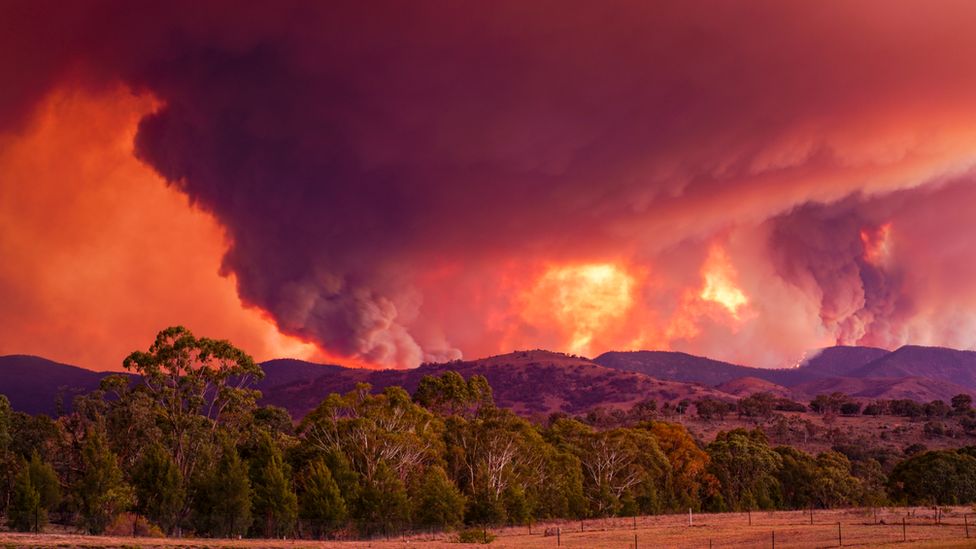
The Role of Carbon
Carbon dioxide is a greenhouse gas, meaning it absorbs the heat that is reflected from Earth’s surface and releases it over time. Its abundance, longevity, and absorption of unique wavelengths explain why carbon is responsible for two-thirds of the energy imbalance that is causing the climate crisis.
Not only is the concentration of carbon dioxide in Earth’s atmosphere higher than it ever has been in the past 800,000 years — the rate at which we accumulate carbon dioxide is now 100 times higher than the rate of natural increases over the past 10,000 years.
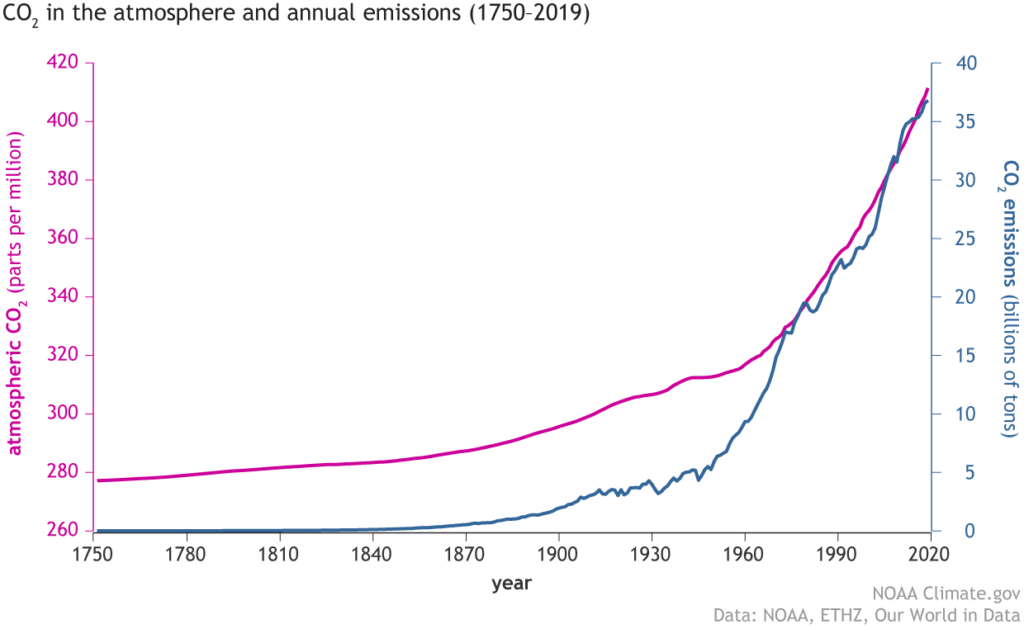
The source of the additional carbon? Fossil fuels. Coal, natural gas and oil contain carbon that plants have used as inputs for photosynthesis over many millions of years. These fuels build up over time as exposure to heat and extreme pressure underground transforms dead plant matter into carbon-dense materials like coal. When these fuels are burned for energy, carbon is released back into the atmosphere at a rate much faster than it was sequestered, or stored.
The continued global use of fossil fuels releases more carbon into the atmosphere, where it accumulates and absorbs more heat reflected off of Earth’s surface, contributing to the greenhouse effect responsible for rising temperatures.
Enter: The Wedge Approach
As concerns about carbon dioxide emissions grew, Princeton professors Stephen Pacala and Robert Socolow began looking ahead to future carbon projections if we continue business-as-usual. In 2004, they announced that to stabilize carbon emissions by 2054, the world must collectively cut carbon emissions by seven gigatons to compensate for the estimated 1.5 gigaton increase per decade.
Pacala and Socolow identified 15 stabilization wedges, or technologies capable of reducing carbon emissions by 1 gigaton — the equivalent of 1,000,000,000 metric tons — each. Through this global commitment to using a combination of 7 stabilization wedges, a wedge approach is feasible to counter climate change and could effectively freeze carbon emissions and prevent further damage.
The impact of these wedges may be visualized as a stabilization triangle, bounded by two possible paths over the next 50 years. Altogether, this represents the eight billion tons of carbon per year (200 billion tons by 2060) that we can prevent from entering our atmosphere if we start making changes now.
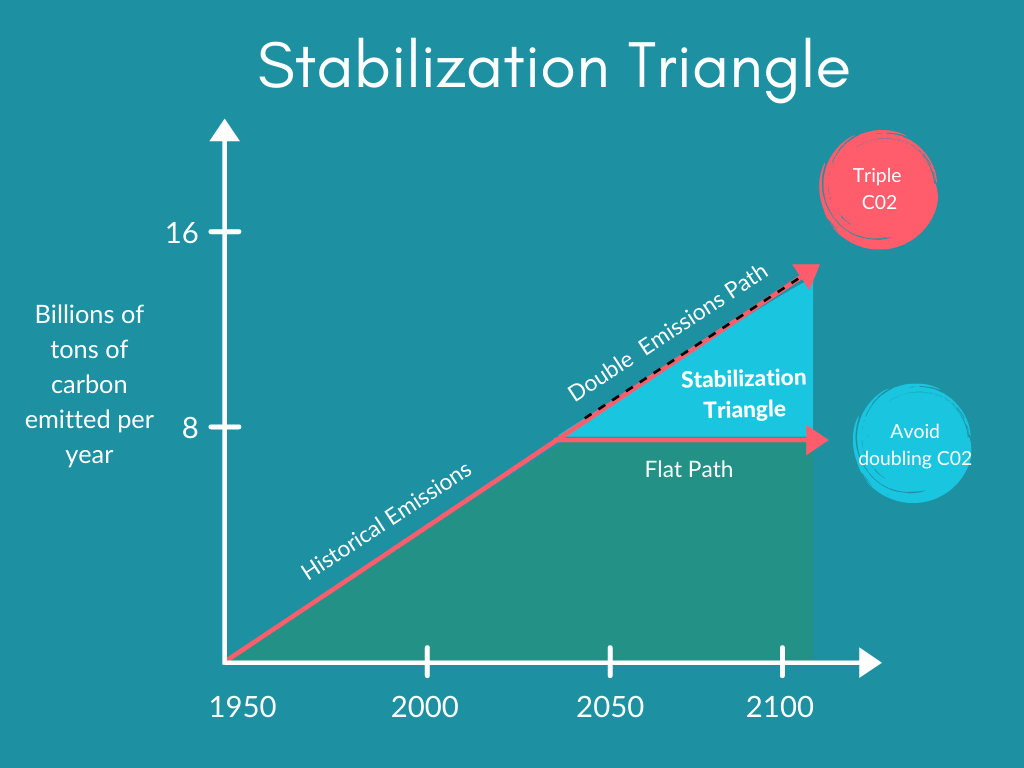
Examples of Wedges
If we want to effectively advocate for solutions like the wedge approach, climate communicators need a firm grasp of what a ‘stabilization wedge’ actually looks like. Below are five of the wedges outlined by Pacala and Socolow, which, if employed on a global scale, have the power to save our planet.
1. Carbon sequestration in the soil
Soil is a readily available sink for 2500 gigatons of carbon — more than triple the capacity of our atmosphere.
What makes soil so unique? Its natural regulation of carbon dioxide via photosynthesis and the weathering of alkaline minerals tagteam to draw out organic and inorganic carbon pools.
Soil organic carbon (SOC) is sequestered when plants extract carbon dioxide from the atmosphere during photosynthesis or when animals decompose in the earth (see below). Increasing SOC storage capacities has been discussed at length around climate movement roundtables.
On the other hand, soil inorganic carbon (SIC) storage capacities are often left out of the conversation. SIC sequestration occurs when carbon dioxide reacts with alkaline rich elements to create carbonate, a stable mineral form capable of storing carbon for long periods of time. This process occurs naturally, but its impact is amplified by human intervention.
A global commitment to applying alkaline minerals to soils could sequester considerably more carbon than photosynthesis alone.
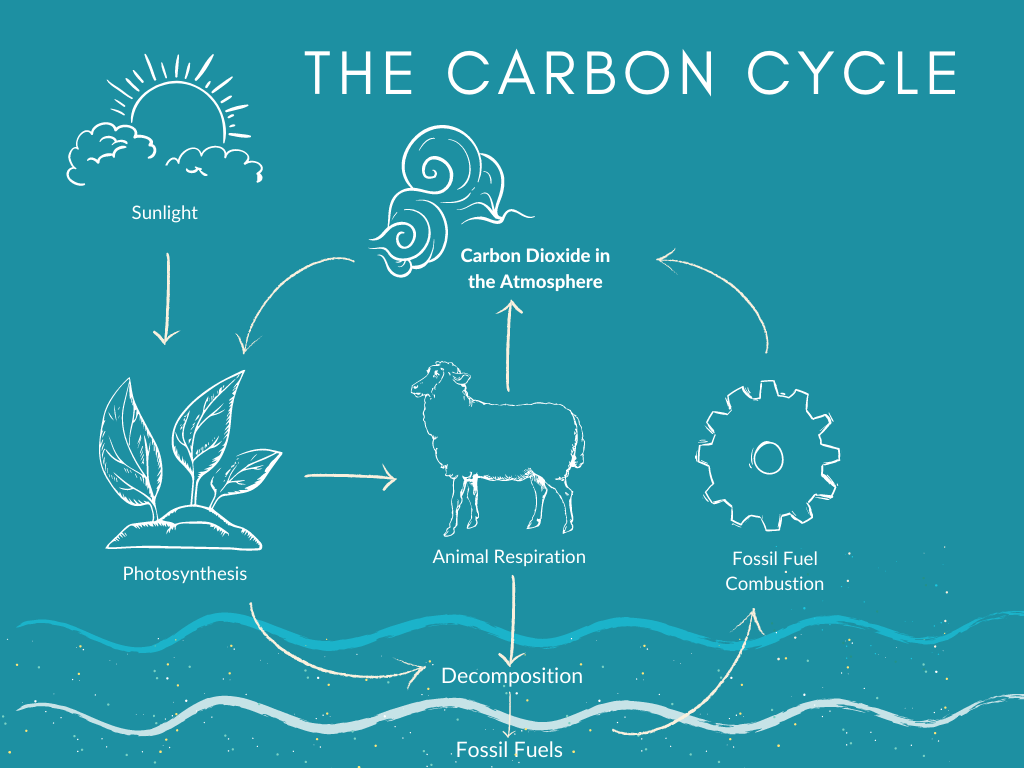
2. Double fuel efficiency of 2 billion cars from 30 to 60 mpg
Much of the technology necessary to double the fuel efficiency of cars either already exists or can be quickly developed with sufficient funding.
Hybrid cars boast impressive fuel efficiencies of 50 mpg, and can be further improved through expanding the storage capabilities of their batteries.
Outside the engine, reducing the average weight of vehicles through substitution with equally safe, lighter materials would lower the amount of gas required to power them. Other improvements include electrical system updates and aerodynamic adjustments to reduce drag.
3. Capture and store emissions from 800 coal electric plants
Whether we like it or not, fossil fuels derived from coal are entrenched so deeply within global infrastructure that a collective transition away from coal-based electricity will take time — maybe too much time.
Do not despair, climate allies: Carbon capture and storage (CCS) from existing coal electric plants is itself a viable stabilization wedge to employ while we bridge the gap toward renewable fuels.
CCS involves sequestering carbon dioxide generated at electric and fuel plants underground, where it may be stored for centuries. A commitment to applying CCS technologies to 800 large coal power plants would negate much of coal-based fuels’ contributions to the climate crisis.
4. Transition from coal-based to solar electricity
Solar electricity has garnered widespread public support over the previous two decades, and rightfully so. It reduces the cost of electricity for consumers, promotes resilience in the electrical grid, and generates back-up power, all while creating jobs and facilitating economic growth.
Installing 100 times the current capacity for solar power would drastically reduce the carbon emissions currently associated with electricity. This impact would triple if we comparably boost the capacities of wind and nuclear electricity.
The good news? The growth of the market has resulted in the lowest cost to install solar panels in history — a trend that will continue into the foreseeable future.
5. Reduce tropical deforestation
Like most plants, tropical forest trees draw carbon dioxide from the atmosphere and release oxygen in its place during photosynthesis. When these trees are cut down and burned for commercial purposes, the carbon they have captured returns to the atmosphere as carbon dioxide, where it is responsible for 10 percent of all global warming emissions.
Legislatively ending or protesting against deforestation and establishing 300 million hectares of new tree plantations would restore tropical forests’ critical ability to sequester carbon before it contributes to the greenhouse effect.
The Wedge Approach, Revisited
In 2011, Robert Socolow published a paper in Climate Central reiterating his confidence in the ability of the wedge approach to stabilize emissions by 2054. He writes that many of the stabilization wedges remain ready for vigorous implementation, but have been stalled by humanity’s “unfamiliar assignment” to work collectively toward one common goal.
The unwelcome news that we must cooperate on a global scale combined with incomplete climate science paraylzed widespread climate action in the 2000s — at a price.
Socolow amends that nine stabilization wedges — two more than postulated by the original calculations — are now required to accomplish the same task. While surely more difficult, our technology and resources render this a feasible feat, and many countries have already climbed on board.
Global Leaders in Carbon Reduction
Since the Paris Agreement in 2016, many countries have taken formidable strides toward reducing their carbon emissions. Here are three of the countries with the best energy report cards:
- Morocco is one of two countries with goals to reduce carbon dioxide emissions enough to limit global temperature rise to the desired 1.5°C (2.7°F). The nation is transitioning to using renewable sources to fuel 52 percent of electricity production and the development of the world’s largest solar farm.
- Gambia, embracing the same goal, has adopted wedges like the construction of one of the world’s largest photovoltaic plants in West Africa and the restoration of 10,000 hectares of forests, mangroves, and savannahs for carbon sequestration.
- India currently invests more in renewable energy than fossil fuels. By 2030, the country plans to generate 40 percent of its power through renewable sources.
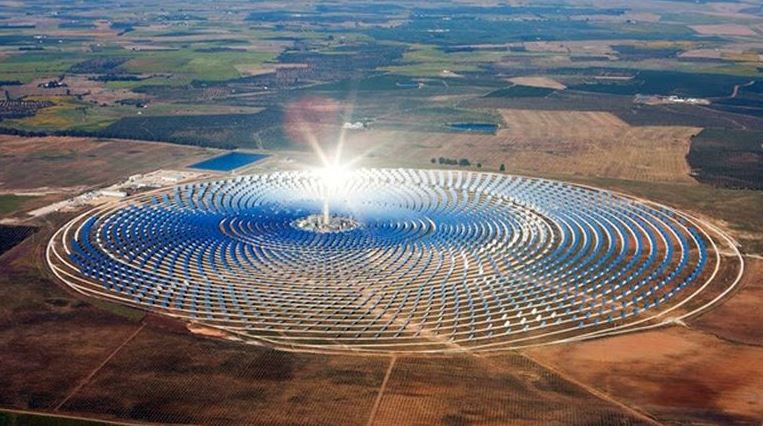
The Role of the Climate Communicator
If we already had the technology and empirical insights to implement any one of Pacala and Socolow’s 15 wedges in 2004, then we are more than prepared in 2021. Climate communicators must assume responsibility for understanding and distributing these solutions so that they can gain meaningful traction.
Small steps like talking about stabilization wedges with a coworker or emailing a public official are easy ways to get the snowball rolling. Talking about climate change can be daunting, and people often freeze up thinking the solutions are non-existent. Providing information regarding one of the 15 potential solutions can instill hope and excitement for what can be done.
Voting is another powerful method of communicating your support for solutions like the wedge approach to members of government. If politicians understand that their constituents care about climate action and have an idea of what it should look like, they will create policies and economic incentives to enforce it. Change on an individual level is important, but to stabilize emissions by 2054, governments need to emulate the actions taken by Morocco, Gambia, and India.
Beacons of Hope
A global commitment to using nine wedges would stabilize carbon emissions by 2054, subduing a pernicious driver of the rising temperatures that threaten the delicate balance of our home. The wedge approach is technologically feasible, but only if governments — urged along by their citizens — work in tandem to institute economic incentives and regulations.

Solutions like the wedge approach are beacons of hope, demonstrating that we do have the knowledge and the technology to build a viable future for our planet — we just need to realize it.






